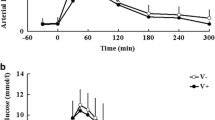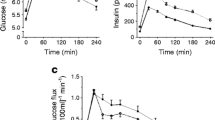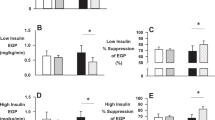Summary
The aim of the study was to evaluate an acute decrease in NEFA levels during an oral glucose tolerance test and its effects on glucose tolerance, muscle glucose uptake and muscle indirect calorimetry in ten lean non-insulin-dependent diabetic subjects. Two 75-g oral glucose tolerance tests were performed in random order. Placebo or 250 mg acipimox (to inhibit lipolysis) were administered orally 2 h before the start of the oral glucose tolerance test. Two hours after acipimox administration (time 0), non-esterified fatty acid, glycerol and 3-hydroxybutyrate levels decreased by 84, 68 and 77% respectively, compared to basal levels. Concomitantly, muscle lipid oxidation and non-oxidative glycolysis also decreased significantly. After placebo administration, non-esterified fatty acids, glycerol and 3-hydroxybutyrate and lipid oxidation increased by 29, 28, 106 and 33%, respectively (NS vs basal levels; p<0.001 vs acipimox). There was a negative rate of net glucose storage (interpreted as glycogenolysis) during post-absorptive conditions and at time 0 after administration of both drugs. After oral glucose tolerance test, the incremental areas of blood glucose and insulin were significantly decreased by 18 and 19% after acipimox compared to placebo. In addition, the ratio between the incremental area of forearm muscle glucose uptake and the insulin levels was significantly increased by 45% during acipimox compared to placebo administration. Glucose oxidation and non-oxidative glycolysis were significantly higher while lipid oxidation was significantly lower after acipimox than after placebo. In conclusion, our study found that in lean non-insulin-dependent diabetic subjects, an acute decrease in non-esterified fatty acid levels improves glucose tolerance, muscle glucose uptake, glucose oxidation and non-oxidative glycolysis, but is unable to normalize glucose storage.
Similar content being viewed by others
Abbreviations
- NEFA:
-
Non-esterified fatty acids
- NIDDM:
-
non-insulin-dependent diabetes mellitus
- OGTT:
-
oral glucose tolerance test
- FMGU:
-
forearm muscle glucose uptake
- FMBF:
-
forearm muscle blood flow
- M:
-
muscle
References
Greenfield M, Kolterman O, Olefsky J, Reaven GM (1980) Mechanism of hypertriglyceridaemia in patients with fasting hyperglycaemia. Diabetologia 18: 441–446
Reaven GM, Geenfield M (1981) Diabetic hypertriglyceridemia: evidence for three clinical syndromes. Diabetes 30: 66–75
Ferrannini E, Barret EJ, Bevilacqua S, DeFronzo RA (1983) Effects of fatty acids on glucose production and utilization in man. J Clin Invest 72: 1737–1747
Piatti PM, Monti LD, Pacchioni M, Pontiroli AE, Pozza G (1991) Forearm glucose uptake and muscle metabolism in man: role of free fatty acids and blood glucose. Metabolism 40: 926–933
Bevilacqua S, Buzzigoli G, Bonadonna R et al. (1990) Operation of Randle's cycle in patients with NIDDM. Diabetes 39: 383–389
Saloranta C, Franssila-Kallunki A, Ekstrand A, Taskinen MR, Groop L (1991) Modulation of hepatic glucose production by non-esterified fatty acids in type 2 (non-insulin dependent) diabetes mellitus. Diabetologia 34: 409–411
Bevilacqua S, Bonadonna R, Buzzigoli G et al. (1987) Acute elevation of free fatty acids leads to hepatic insulin resistance in obese subjects. Metabolism 36: 502–506
Randle PJ, Newsholme EA, Garland PB (1964) Regulation of glucose uptake by muscle. Effects of fatty acids, ketone bodies, and pyruvate, and of alloxan-diabetes, and starvation, on the uptake and metabolic fate of glucose in rat heart and diaphragm muscles. Biochem J 93: 652–665
Vaag A, Skott P, Damsbo P, Gall MA, Richter EA, Beck-Nielsen H (1991) Effect of the antilipolytic nicotinic acid analogue acipimox on whole-body and skeletal muscle glucose metabolism in patients with non-insulin-dependent diabetes mellitus. J Clin Invest 88: 1282–1290
Fulcher GR, Walker M, Catalano C, Agius L, Alberti KGMM (1992) Metabolic effects of suppression of nonesterified fatty acid levels with acipimox in obese NIDDM subjects. Diabetes 41: 1400–1408
Saloranta C, Taskinen MR, Widen E, Harkonen M, Melander A, Groop L (1993) Metabolic consequences of sustained suppression of free fatty acids by acipimox in patients with NIDDM. Diabetes 42: 1559–1566
Groop L, Saloranta C, Shank M, Bonadonna RC, Ferrannini E, DeFronzo RA (1991) The role of free fatty acid metabolism in the pathogenesis of insulin resistance in obesity and non-insulin-dependent diabetes mellitus. J Clin Endocrinol Metab 72: 96–107
Felber JP, Ferrannini E, Golay A et al. (1987) Role of lipid oxidation in pathogenesis of insulin resistence of obesity and type II diabetes. Diabetes Metab Rev 36: 1341–1350
Golay A, Felber JP, Jequier E, De Fronzo RA, Ferrannini E (1988) Metabolic basis of obesity and non-insulin dependent diabetes mellitus. Diabetes Metab Rev 4: 727–747
Capaldo B, Napoli R, DiMarino L, Picardi A, Riccardi G, Saccà L (1988) Quantitation of forearm glucose and free fatty acid (NEFA) disposal in normal subjects and type II diabetic patients. Evidence against an essential role for NEFA in the pathogenesis of insulin resistance. J Clin Endocrinol Metab 67: 893–898
Walker M, Agius L, Ørskov H, Alberti KGMM (1993) Peripheral and hepatic insulin sensitivity in non-insulin-dependent diabetes mellitus: effect of nonesterified fatty acids. Metabolism 42: 601–608
Yki-Jarvinen H, Young AA, Lamkin C, Foley JM (1987) Kinetics of glucose disposal in whole body and across the forearm in men. J Clin Invest 79: 1713–1719
Meistas MT, Frederka V, Vlachokosta V, Gleason RE, Arcangeli M, Aoki TT (1985) Role of muscle in CO2 production after oral glucose administration in men. Diabetes 34: 360–363
Kelley DE, Mitrakou A, Marsh H et al. (1988) Skeletal muscle glycolysis, oxidation, and storage of an oral glucose load. J Clin Invest 81: 1563–1571
Kelley DE, Reilly J, Veneman T, Mandarino LJ (1990) The influence of physiologic hyperinsulinemia on skeletal muscle glucose storage oxidation, and glycolysis in man. Am J Physiol 258: E923–E929
Kelley DE, Mandarino LJ (1990) Hyperglycemia normalizes insulin-stimulated skeletal muscle glucose oxidation and storage in noninsulin-dependent diabetes mellitus. J Clin Invest 86: 1999–2007
Natali A, Buzzigoli G, Taddei S et al. (1990) Effects of insulin on hemodynamics and metabolism in human forearm. Diabetes 39: 490–500
Ferrannini E (1988) The theoretical basis of indirect calorimetry: a review. Metabolism 37: 287–301
Forster HV, Dempsey JA, Thomson J, Vidruk E, dePico GA (1972) Estimation of arterial PO2, PCO2, pH and lactate from arterialized venous blood. J Appl Physiol 32: 134–137
Harrison J, Hodson AW, Skillen AW, Stappenbeck R, Agius L, Alberti KGMM (1988) Blood glucose, lactate, pyruvate, glycerol, 3-hydroxybutyrate and acetoacetate measurements in man using a centrifugal analyser with fluorimetric attachment. J Clin Chem Clin Biochem 26: 141–146
Soeldner JS, Slone D (1965) Critical variables in the radioimmunoassay of serum insulin using the double antibody technique. Diabetes 14: 771–779
Knox DP, Jones DG (1984) Automatic enzymatic determination of plasma free fatty acids by centrifugal analysis. J Autom Chem 6: 152–154
Douglas A, Jones N, Reed J (1988) Calculation of whole blood CO2 content. J Appl Physiol 65: 473–477
Andres R, Cader G, Zierler KL (1956) The quantitatively minor role of carbohydrate in oxidative metabolism by skeletal muscle in intact man in the basal state, measurements of oxygen and glucose uptake and carbon dioxide and lactate production in the forearm. J Clin Invest 35: 671–682
Mandarino LJ, Wright KS, Verity LS et al. (1987) Effects of insulin infusion on human skeletal muscle pyruvate dehydrogenase, phosphofructokinase, and glycogen synthase. Evidence for their role in oxidative and nonoxidative glucose metabolism. J Clin Invest 80: 655–663
Mandarino LJ, Consoli A, Jain A, Kelley DE (1993) Differential regulation of intracellular glucose metabolism by glucose and insulin in human muscle. Am J Physiol 265: E898–E905
Kelley DE, Simoneau J-A (1994) Impaired free fatty acid utilization by skeletal muscle in non-insulin-dependent diabetes mellitus. J Clin Invest 94: 2349–2356
Piatti PM, Monti LD, Baruffaldi L et al. (1995) Effects of an acute increse in plasma triglyceride levels on glucose metabolism in man. Metabolism 44: 883–889
Vaag A, Henriksen JE, Beck-Nielsen H (1992) Decreased insulin activation of glycogen synthase in skeletal muscles in young non-obese Caucasian first-degree relatives of patients with non-insulin-dependent diabetes mellitus. J Clin Invest 89: 782–788
Kelley DE, Mokan M, Simoneau JA, Mandarino LJ (1993) Interaction between glucose and free fatty acid metabolism in human skeletal muscle. J Clin Invest 92: 91–98
Youn JH, Bergman RN (1991) Conversion of oral glucose to lactate in dogs. Primary site and relative contribution to blood lactate. Diabetes 40: 738–747
Puhakainen I, Yki-Jarvinen H (1993) Inhibition of lipolysis decreases lipid oxidation and gluconeogenesis from lactate but not fasting hyperglycemia or total hepatic glucose production in NIDDM. Diabetes 42: 1694–1699
Worm D, Henriksen JE, Vaag A, Thye-Ronn P, Melander A, Beck-Nielsen H (1994) Pronounced blood glucose-lowering effect of the antilipolytic drug acipimox in noninsulin-dependent diabetes mellitus patients during a 3-day intensified treatment period. J Clin Endocrinol Metab 78: 717–721
Saloranta C, Franssila-Kallunki A, Ekstrand A, Taskinen M-R, Groop LC (1991) Modulation of hepatic glucose production by non-esterified fatty acids in type 2 (non-insulin-dependent) diabetes mellitus. Diabetologia 34: 409–415
Taylor R, Price TB, Kats LD, Shulman RG, Shulman GI (1993) Direct measurement of change in muscle glycogen concentration after a mixed meal in normal subjects. Am J Physiol 265: E224–E229
Fulcher GR, Walker M, Farrer M, Johnson AS, Alberti KGMM (1992) Acipimox increases glucose disposal in normal man independent of changes in plasma nonesterified fatty acid concentration and whole-body lipid oxidation rate. Diabetes 41: 1400–1408
Astrup A, Simonsen L, Bulow J, Christensen NJ (1988) Measurement of forearm oxygen consumption: role of heating the contralateral hand. Am J Physiol 225: E572–E578
Liu D, Moberg E, Kollind M, Lins P-E, Adamson U, Macdonald IA (1992) Arterial, arterialized venous, venous and capillary blood glucose measurements in normal man during hyperinsulinaemic euglycaemia and hypoglycaemia. Diabetologia 35: 287–290
Gallen IW, Macdonald IA (1990) Effect of two methods of hand heating on body temperature, forearm blood flow, and deep venous oxygen saturation. Am J Physiol 259: E639–E643
Author information
Authors and Affiliations
Rights and permissions
About this article
Cite this article
Piatti, P.M., Monti, L.D., Davis, S.N. et al. Effects of an acute decrease in non-esterified fatty acid levels on muscle glucose utilization and forearm indirect calorimetry in lean NIDDM patients. Diabetologia 39, 103–112 (1996). https://doi.org/10.1007/BF00400420
Received:
Revised:
Issue Date:
DOI: https://doi.org/10.1007/BF00400420




